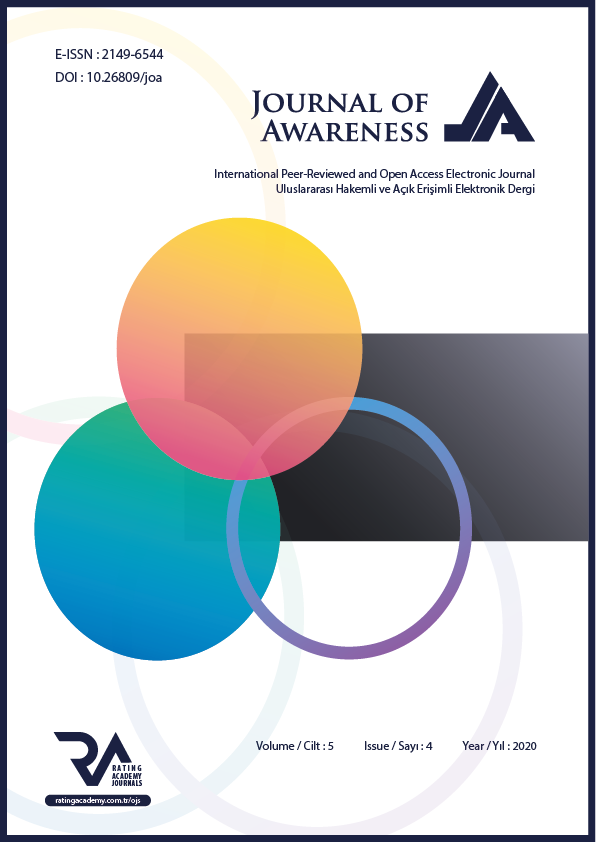GEOGRAPHIC ANALYSIS OF FACTORS AFFECTING AGRICULTURE IN UMURBEY RIVER BASIN (ÇANAKKALE-LAPSEKİ)
DOI:
https://doi.org/10.26809/joa.5.041Keywords:
Agricultural Geography, Agricultural Potential, River Basin, Umurbey River Basin, ÇanakkaleAbstract
Agriculture, is an indispensable sector of the economy due to the production of basic nutrients in meeting human nutritional needs, providing input to other sectors, creating jobs, direct or indirect contributions to exports. Technological advances and the application of modern agricultural methods make it necessary to determine the natural and human potential of basins where agricultural activities are carried out. In this study, It is aimed to identify the natural and human environmental factors that affect agriculture in the Umurbey River Basin and therefore contribute to the development of agriculture in this basin. For this purpose, topographical maps and various statistics of the the basin were used. ArcGIS10 program was also used to explain the spatial characteristics of the research site more clearly. Field studies conducted during the study period contributed greatly to the current state analysis of the agricultural activities of the basin, determining the physical and human factors and problems that affect them. This basin has a great potential in terms of agriculture. As of 2018, 81,549 decars (22.1%) of the total area of the basin (339,354 decars) were agricultural areas, while 86,670 tons of plant production were manifactured. 19,247 decars agricultural areas were not used in agricultural activities in 2018. In this basin, reduced rainfall in summer, forested areas, mountainous and hilly topography limit the agricultural areas. Inability to use agricultural potential efficiently, irrigation problems, soil problems and erosion, as well as the threat of settling in agricultural areas and improper use of land, unused agricultural areas, problems in animal husbandry, decrease in the economic return of agricultural products, migration of the young population, lack of knowledge and education on agriculture, inadequacy in marketing and branding, etc. constitute the main problems in the Umurbey Stream basin. Limited studies that will contribute to the development of agricultural activities in the basin increase the importance of this study from a field point of view.
Downloads
References
ALİAĞAOĞLU, A., (2019), Tarihsel Süreçte Dünya'da ve Türkiye'de Tarım Coğrafyası Alanındaki Çalışmalar, Coğrafi Bilimler Dergisi, 17 (2), 367-383.
AKBULAK, C., (2009), İznik Depresyonu’nun Beşeri ve İktisadi Coğrafya Açısından İncelenmesi, İstanbul Üniversitesi Sosyal Bilimler Enstitüsü Coğrafya Anabilim Dalı Doktora Tezi, İstanbul.
AKGİŞ, Ö., KARAKAŞ, E., (2019), Coğrafyada Kalkınma Araştırmalarının Kısa Tarihi, Türk Coğrafya Dergisi, (72), 85‐91.
DOĞANER, S., (1994), Çanakkale Boğazı Kıyılarının Coğrafyası, Türk Coğrafya Dergisi, (29), 125-159, İstanbul.
DOĞAN, M., (2005), Türkiye Ziraatinde Makineleşme: Traktör ve Biçerdöverin Etkileri, İÜ Ed. Fak. Coğrafya Bölümü Coğrafya Dergisi, (14), 66-75.
ERİNÇ, S., (1957), Tatbiki Klimatoloji ve Türkiye'nin İklim Şartları. İTÜ Hidroloji Enst. Yay. S:2 İstanbul.
ERİNÇ, S., (1984), Klimatoloji ve Metodları (Üçüncü baskı). İÜ Deniz Bilimleri ve Coğrafya Enst. İstanbul.
EROL, O., (1985), Çanakkale Yöresi Güney Kesiminin Jeomorfolojisi, Geomorphology of the Southern Part of the Çanakkale (Dardanelles) District (Abstract). Jeomorfoloji Dergisi Sayı:13: 1-8. Ankara
GARİPAĞAOĞLU, N., UZUN, M., (2019), İznik Gölü Havzası’nda Doğal Ortam Koşulları, Değişimler ve Muhtemel Risklerin Havza Yönetimi ve Planlamasına Etkisi, Doğu Coğrafya Dergisi 24(42), 1-15.
ILGAR, R., (2010), Çanakkale’de Kuraklık Durumu ve Eğilimlerinin Standartlaştırılmış Yağış İndisi ile Belirlenmesi, Marmara Coğrafya Dergisi, (22), 183-204.
KHGM-Köy Hizmetleri Genel Müdürlüğü-(1999), Çanakkale İli Arazi Varlığı. T.C. Başbakanlık Köy Hizmetleri Genel Müdürlüğü Yay., İl rapor no: 17, Ankara.
KOÇ, T., (2001), Çanakkale’de Yağış Potansiyeli , Türk Coğrafya Kurumu 29. Coğrafya Meslek Haftası, Çanakkale, Türkiye, 17-19 Mayıs 2001, ss.1-10.
KOÇMAN, A. (1993), Türkiye İklimi, Ege Üniversitesi Yayınları, No:72, İzmir.
PARLAK, M., YİĞİNİ, Y., EKİNCİ, H., (2014), Çanakkale Umurbey Ovası Topraklarının Erozyona Duyarlılığının Mevsimsel Değişimi, Çanakkale Onsekiz Mart Üniversitesi Ziraat Fakültesi Dergisi, 2(1), 123-131.
ÖZBEK, S., (1978), Özel Meyvecilik. Çukurova Üniversitesi Ziraat Fakültesi Yayınları 128, Ders Kitabı: 11, 392-483.
SERTKAYA DOĞAN, Ö., (2008), Türkiye’nin Tarım Politikalarının Belirlenmesinde Coğrafi Özelliklerin Önemi, Sosyoloji Dergisi, 3 (17). Sayı:2008/2, 91·100.
TEMUÇİN, E., (1990), Aylık Değişme Oranlarına Göre Türkiye’de Yağış Rejimi Tipleri, Ege Coğrafya Dergisi, Sayı 5, 160-183.
TÜİK., Türkiye İstatistik Kurumu, ADNKS 2007-2018 Yılı Nüfus Sayımı Sonuçları.
TÜMERTEKİN, E., ÖZGÜÇ, N., (2009), Ekonomik Coğrafya Kalkınma ve Küreselleşme (17.baskı), Çantay Kitabevi, İstanbul.
TÜRKEŞ, M., (2007), Prof. Dr. Oğuz EROL’a Göre Çanakkale Yöresinin Jeomorfolojik ve Neotektonik Evrimi, Çanakkale Araştırmaları Türk Yıllığı, 129-145.
TÜRKEŞ, M., (2010), Klimatoloji ve Meteoroloji. Birinci Baskı, Kriter Yayınevi – Yay. No. 63, Fiziki Coğrafya Serisi No. 1, ISBN: 978-605-5863-39-6, 650 + XXII sayfa, İstanbul.
TÜRKEŞ, M., ALTAN, G., (2014), Çanakkale Yöresinde Oluşan Orman Yangınlarının Hidroklimatolojik Karakteristikleri ve İklim Değişimleriyle İlişkisi, Ege Coğrafya Dergisi, (20/2), 1-25.
YALÇINLAR, İ., (1948), Çanakkale Boğazı Civarının Jeomorfolojisi Üzerine Müşahedeler, Türk Coğrafya Dergisi, 11-12.
URL-1: http://www.fao.org/statistics/en/ (Erişim Tarihi: 15.02.2020)
URL-2: https://data.worldbank.org/indicator/NV.AGR.TOTL.ZS (Erişim Tarihi: 06.03.2020)
URL-3: https://www.turkiye.gov.tr/tuik-gostergeler (Erişim Tarihi: 06.03.2020)
URL-4: https://webdosya.csb.gov.tr/db/ced/icerikler/canakkale_-cdr2018-20200123080146.pdf (Erişim Tarihi: 13.09.2019)
URL-5: http://www.tuik.gov.tr/UstMenu.do?metod=temelist (Erişim Tarihi: 09.09.2019)
URL-6:.https://webdosya.csb.gov.tr/db/ced/editordosya/Canakkale_icdr2012.pdf
(Erişim Tarihi 23.04.2020)
Downloads
Published
How to Cite
Issue
Section
License
Copyright (c) 2020 Holistence Publications

This work is licensed under a Creative Commons Attribution 4.0 International License.
When the article is accepted for publication in the Journal of Awareness, authors transfer all copyright in the article to the Rating Academy Ar-Ge Yazılım Yayıncılık Eğitim Danışmanlık ve Organizasyon Ticaret Ltd. Şti.The authors reserve all proprietary right other than copyright, such as patent rights.
Everyone who is listed as an author in this article should have made a substantial, direct, intellectual contribution to the work and should take public responsibility for it.
This paper contains works that have not previously published or not under consideration for publication in other journals.











